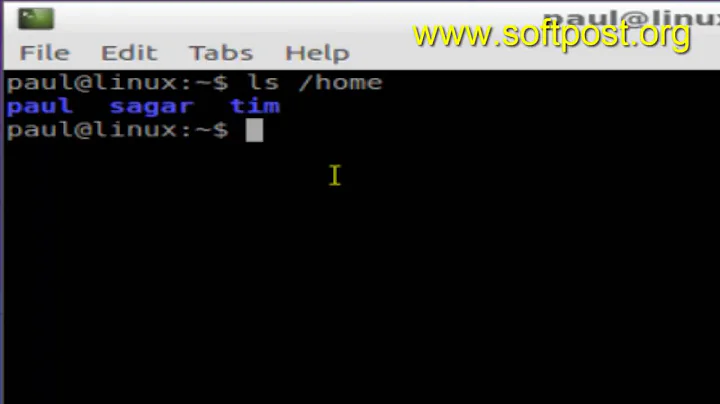How can I retrospectively create a default home directory for an existing user in terminal?
Solution 1
Use the following (as root, or with sudo if not root):
mkhomedir_helper username
For this to work, folder /home/username must not exist.
For X-related folders (Desktop, Downloads, etc), you will need to login in a graphics environment; they will be automatically generated the first time you login.
Solution 2
The subdirectories (Documents, Downloads, etc...) are automatically created when the user first logs in through GNOME, provided that the home directory is created with the correct permissions. Here's a demonstration:
alaa@aa-lu:~$ sudo useradd testinguser alaa@aa-lu:~$ sudo passwd testinguser Enter new UNIX password: Retype new UNIX password: passwd: password updated successfully alaa@aa-lu:~$ sudo ls -l /home total 20 drwxr-xr-x 55 alaa alaa 4096 Aug 22 22:00 alaa drwx------ 2 root root 16384 Jun 5 09:46 lost+found alaa@aa-lu:~$ sudo mkdir /home/testinguser alaa@aa-lu:~$ sudo chown testinguser:testinguser /home/testinguser alaa@aa-lu:~$ ls -l /home total 24 drwxr-xr-x 55 alaa alaa 4096 Aug 22 22:00 alaa drwx------ 2 root root 16384 Jun 5 09:46 lost+found drwxr-xr-x 2 testinguser testinguser 4096 Aug 23 10:03 testinguser alaa@aa-lu:~$ ls -l /home/testinguser/ total 0 alaa@aa-lu:~$
You can check that the user's home directory is correctly set by checking the entry in /etc/passwd. You should, by default, see the home directory set to /home/testinguser:
alaa@aa-lu:~$ grep testinguser /etc/passwd testinguser:x:1001:1001::/home/testinguser:/bin/sh
If you don't see the home directory /home/testinguser there, you'll need to execute the command sudo usermod -d /home/testinguser testinguser to update it, although you should not need to use this command because it should be set by default (according to useradd's manpages).
I then logged out of my account, and logged back in with testinguser, and here are the subdirectories automatically created:

alaa@aa-lu:~$ ls -l /home/testinguser/ total 36 drwxr-xr-x 2 testinguser testinguser 4096 Aug 23 10:05 Desktop drwxr-xr-x 2 testinguser testinguser 4096 Aug 23 10:05 Documents drwxr-xr-x 2 testinguser testinguser 4096 Aug 23 10:05 Downloads drwxr-xr-x 2 testinguser testinguser 4096 Aug 23 10:05 Music drwxr-xr-x 2 testinguser testinguser 4096 Aug 23 10:07 Pictures drwxr-xr-x 2 testinguser testinguser 4096 Aug 23 10:05 Public drwxr-xr-x 2 testinguser testinguser 4096 Aug 23 10:05 Templates drwxr-xr-x 2 testinguser testinguser 4096 Aug 23 10:05 Videos
I didn't need to copy the contents of /etc/skel.
If possible, can you please try following these steps, creating another new user? Once you're done, you can remove this new user by sudo deluser testinguser && sudo rm -r /home/testinguser.
If all of this did not work with you, then I'm guessing it's a bug.
Solution 3
UPDATE: The solution is broken and not working for me too.
If you want to create the user's home directory if it does not exist, then run the useradd command with the -m flag. This will copy all files from the /etc/skel directory.
useradd -m username
You might need to configure settings for your system. According to the man page :
-m, --create-home
Create the user's home directory if it does not exist. The files and directories
contained in the skeleton directory (which can be defined with the -k option)
will be copied to the home directory.
By default, if this option is not specified and CREATE_HOME is not enabled, no
home directories are created.
and further indicates :
CONFIGURATION
The following configuration variables in /etc/login.defs change the behavior
of this tool:
CREATE_HOME (boolean)
Indicate if a home directory should be created by default for new users.
Solution 4
If you created the new user with adduser command, you don't need to create a home directory for the new user. A home directory named with the name of the user in /home directory, with the following subdirectories: Desktop, Downloads, Documents, Music, Pictures, Videos (and others), for the new user will be created automatic.
If you created the new user with useradd command, then run the following commands in terminal:
sudo -i #enter your user password when you are asked
gedit /etc/passwd
to edit /etc/passwd file as root (this is the most important step). Find the line with the name of the new user and set the default home directory for him something like this:
new_username:x:1001:1001::/home/new_username:/bin/sh
At this line you can also to add a real name for the new user, or set the default shell. Something like this:
new_username:x:1001:1001:Real New Username,,,:/home/new_username:/bin/bash
Be careful, don't make any other changes.
After you save the file, before to go out from the root account, run the following commands:
mkdir /home/new_username #to create the directory /home/new_username
cp -r /etc/skel/. /home/new_username #to copy skeleton files to /home/new_username
chown -R new_username:new_username /home/new_username #to change the owner of /home/new_username to the new user
After all of these the home folder for the new user will automatically be populated after first login.
See also: How to make user home folder after account creation?
Solution 5
All you need realy is the home folder to make it work. As root,
cd /home
cd mkdir username
chown username username
chgrp username username
Logging in with the first time should create all necessary files, that seems to be those:
drwxr-xr-x 16 fotanus fotanus 4096 Jun 4 17:46 .
drwxr-xr-x 9 root root 4096 Jun 4 17:43 ..
drwx------ 11 fotanus fotanus 4096 Jun 4 17:46 .cache
drwx------ 13 fotanus fotanus 4096 Jun 4 17:46 .config
drwxr-xr-x 2 fotanus fotanus 4096 Jun 4 17:45 Desktop
drwxr-xr-x 2 fotanus fotanus 4096 Jun 4 17:45 Documents
drwxr-xr-x 2 fotanus fotanus 4096 Jun 4 17:45 Downloads
drwx------ 3 fotanus fotanus 4096 Jun 4 17:46 .gconf
drwxrwxr-x 2 fotanus fotanus 4096 Jun 4 17:46 .gstreamer-0.10
-rw------- 1 fotanus fotanus 334 Jun 4 17:45 .ICEauthority
drwxr-xr-x 3 fotanus fotanus 4096 Jun 4 17:45 .local
drwx------ 4 fotanus fotanus 4096 Jun 4 17:45 .mozilla
drwxr-xr-x 2 fotanus fotanus 4096 Jun 4 17:45 Music
drwxr-xr-x 2 fotanus fotanus 4096 Jun 4 17:45 Pictures
drwxr-xr-x 2 fotanus fotanus 4096 Jun 4 17:45 Public
drwxr-xr-x 2 fotanus fotanus 4096 Jun 4 17:45 Templates
drwxr-xr-x 2 fotanus fotanus 4096 Jun 4 17:45 Videos
-rw------- 1 fotanus fotanus 55 Jun 4 17:45 .Xauthority
-rw------- 1 fotanus fotanus 711 Jun 4 17:45 .xsession-errors
Related videos on Youtube
Jo Rijo
Updated on September 18, 2022Comments
-
Jo Rijo over 1 year
I created a user without a home directory and now I want to create a home directory for them. Not just a folder called
/home/new-user, but a complete default home directory with all the normal folders and hidden files, etc.How can I do that?
-
Alaa Ali over 10 yearsWhen the user logs in, those subdirectories (Documents, Downloads, etc...) will be automatically created. Although I'm searching for ways to "simulate" his login through the terminal.
-
Radu Rădeanu over 10 years@Alaa
su new_user:D -
Alaa Ali over 10 years@RaduRădeanu yeah I already tried that, also tried
sudo -i -u new_userbut it doesn't work. I think we need to "simulate an X login"...don't know how to do that. -
Jo Rijo over 10 yearslogging in doesn't create the subdirectories in home.
-
-
Alaa Ali over 10 yearsAs far as I remember, the home folder is not automatically created, you have to manually create it and update the user's entry in
/etc/passwd(if it's not already there). Once the user logs in, the home folder will automatically be populated with those subdirectories. However, all of this is taken care of is someone adds a user usingadduser, instead ofuseradd. -
Radu Rădeanu over 10 years@Alaa I just tested a few days ago and I used
adduser: the home folder is automatically created. And indeed, the home folder will automatically be populated after first login. -
Jo Rijo over 10 yearsthis seems to try to create a new user, because it tells me "user 'new-user' already exists".
-
Jo Rijo over 10 yearsthis seems to do nothing.maybe I'll try the bash script from the other question, but couldn't I just create a folder in /home/ called new_user, and then copy the contents of /etc/skel to it? is that what that bash-script does?
-
Radu Rădeanu over 10 years@JoRijo I edited my answer.
-
crafter over 10 years@Jo: And how is this incorrect, because according the initial post, the user does already exist.
-
Radu Rădeanu over 10 yearsIn some situation when you use
useradd, the default home directory for the new user is not automatic set to/home/username. So, first ypu must to be sure about that. -
Alaa Ali over 10 yearsCan you give me an example of these situations =)? From the man pages of
useradd: "useradd will use the base directory specified by the HOME variable in/etc/default/useradd, or/homeby default". The HOME variable in/etc/default/useraddis not defined by default, so useradd will always use/home. Anyways, I'll edit my answer and move the part to check/etc/passwdup. -
Radu Rădeanu over 10 yearsAn example here. Another example: You delete an user, but you didn't delete his directories and files; and then you add again a user with the same name. And there are many, and there are no bugs :)
-
Radu Rădeanu over 10 years@Alaa Well, thanks for observation. Also you can edit yourself an answer when you see some mistakes like these.
-
Alaa Ali over 10 yearsThis answer does not solve the issue. Copying
/etc/skeldoes not create the subdirectories in the home directory. Also,useradd -mis used when creating a new user, not when the user is already added. -
gerlos about 9 yearsSimple and useful. This way you also can be sure that the newly created home dir is compliant with your system policies, without ever knowing them or any manual tinkering.
-
Uzair Gheewala almost 9 yearsThis is the correct answer, at least it worked for me on Ubuntu 14.04.2 LTS.
-
user79878 over 8 yearsI had to have my username in /etc/passwd first before this worked for me.
-
Newtopian about 8 yearsSimple.. just works (tm). Should be the accepted answer
-
ntwrkguru over 5 yearsNot all systems have GNOME and suggesting someone to remove and re-add a user simply to create a home directory is bad advice.
-
Don Kirkby over 5 yearsDon't forget to check the directory's permissions with
ls -l /home. I found that the new directory was readable by all other users, so I removed those permissions withchmod go-r-x /home/username. -
 Desik about 4 yearsThis doesn't create the files insde home, like
Desik about 4 yearsThis doesn't create the files insde home, like.bashrc. Didn't work for me. -
 Themelis almost 4 yearsThat's the best answer
Themelis almost 4 yearsThat's the best answer -
Jesse Nickles almost 3 years@Desik make sure you run as
rootorsudoit seems to work. -
imz -- Ivan Zakharyaschev over 2 years@Desik Have a look with
ls -a. Perhaps, the files are there, but a simplelsdoesn't show them. Also I had the same impression (that it didn't work), because/home/was mounted read-only when I did it.




